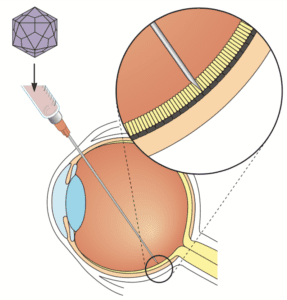

Phylogenetic analyses of sequences of the major capsid protein (VP3) of 75 AAV isolates and variants that occur naturally in primates and assemble efficiently into capsids were used to develop a model of AAV evolution and identify putative ancestral AAVs (Ancs). One ancestor that occurred early in the phylogeny of most primate AAVs and parallel to the early speciation of human AAV4 and AAV5 was chosen for reconstruction. This virus, called Anc80, was selected because it is the putative ancestor of several human AAV serotypes that are widely used in gene therapy trials.
Because maximum likelihood methods were used to predict the sequence of Anc80 VP3, some positions had only a low probability score. A library of VP3 sequences was therefore constructed in which all possible amino acids were included at these low probability positions. The library was screened initially for production of virus particles that could package a luciferase reporter gene, and those which supported the highest luciferase activity were further examined for the production of virus particles and infectivity. One candidate, AAVAnc80L65, was selected for further characterization.
When evaluated for delivery of a GFP transgene to different tissues in mice, the AAVAnc80L65 vector transduced cells of the liver, skeletal muscle and the eye (both photoreceptors and retinal pigment epithelial cells) more efficiently than either AAV2 or AAV 8. No signs of toxicity were observed and the was resistant to neutralizing with antibodies against AAV2 and AAV8.
Ancestral sequence reconstruction is a novel approach to improve the properties of a well studied gene therapy vector, and might be applicable to other gene therapy vectors such as adenoviruses. Because of its safety and high efficiency of transduction, AAVAnc80L65 vectors are likely to have broad applications for gene therapy. This vector has already been shown to achieve therapeutic gene delivery in a mouse model of Usher syndrome, which causes balance disorders and profound deafness, and to efficiently transduce cochlear cells of the inner ear, cells of the central nervous system and kidney mesenchymal cells in vivo.
